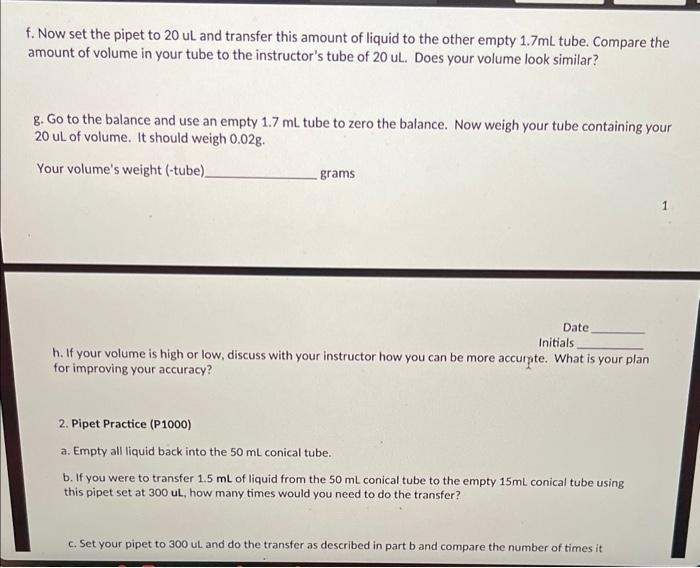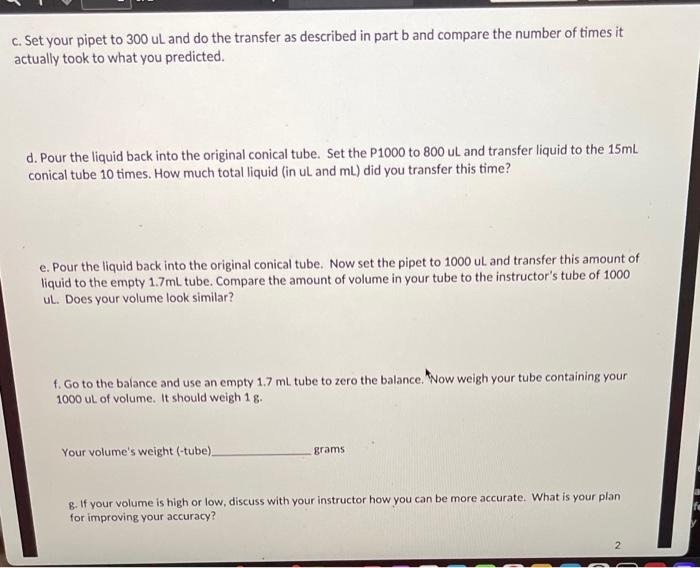Answered step by step
Verified Expert Solution
Question
1 Approved Answer
solve it for me please and show work Why? Much of what molecular biologists, biochemists, and organic chemists work with is very expensive, so we
solve it for me please and show work 


Why? Much of what molecular biologists, biochemists, and organic chemists work with is very expensive, so we try to work in VERY small volumes to limit waste and be frugal. So, it is important to learn to use the measurement tools in these small volumes very accurately and precisely. For example, 1uL variation in a 10uL reaction is a 10% error. What to turn in: Put today's date and your initials on these notes, record what you've done and any changes made to the protocol on the protocol paper. These notes should then be scanned to a pdf with all of today's notes. This file goes in the Module 1 dropbox. 1. Pipet Practice (P20) a. Get two empty 1.7mL tube and two conical tubes (50mL with liquid; 15mL empty). Gradation markings are mostly accurate for these tubes and are found on the side. b. Look at the volume notations on the side of the tube with the liquid. How much volume is in the tube in mL ? What is this same volume in ul? c. If you were to transfer 180 uL of liquid from the conical tube with liquid to the first empty 1.7mL tube using this pipet set at 10uL, how many times would you need to do the transfer? d. Set your pipet to 10uL and do the transfer as described in part C and compare the number of times it actually took to what you predicted. e. Pour or tap the liquid back into the original conical tube. Set the P20 to 2 uL and transfer liquid to the nearly empty container an additional 10 times. How much total liquid (in uL and mL ) did you transfer this time? f. Now set the pipet to 20uL and transfer this amount of liquid to the other empty 1.7mL tube. Compare the amount of volume in your tube to the instructor's tube of 20uL. Does your volume look similar? g. Go to the balance and use an empty 1.7mL tube to zero the balance. Now weigh your tube containing your 20uL of volume. It should weigh 0.02g. Your volume's weight (-tube) grams Date Initials h. If your volume is high or low, discuss with your instructor how you can be more accurpte. What is your plan for improving your accuracy? 2. Pipet Practice (P1000) a. Empty all liquid back into the 50mL conical tube. b. If you were to transfer 1.5mL of liquid from the 50mL conical tube to the empty 15mL conical tube using this pipet set at 300uL, how many times would you need to do the transfer? c. Set your pipet to 300uL and do the transfer as described in part b and compare the number of times it c. Set your pipet to 300uL and do the transfer as described in part b and compare the number of times it actually took to what you predicted. d. Pour the liquid back into the original conical tube. Set the P1000 to 800 uL and transfer liquid to the 15mL conical tube 10 times. How much total liquid (in uL and mL ) did you transfer this time? e. Pour the liquid back into the original conical tube. Now set the pipet to 1000uL and transfer this amount of liquid to the empty 1.7mL tube. Compare the amount of volume in your tube to the instructor's tube of 1000 uL. Does your volume look similar? f. Go to the balance and use an empty 1.7mL tube to zero the balance. Now weigh your tube containing your 1000 ul of volume. It should weigh 1g. Your volume's weight (-tube) grams g. If your volume is high or low, discuss with your instructor how you can be more accurate. What is your plan for improving your accuracy 


Step by Step Solution
There are 3 Steps involved in it
Step: 1

Get Instant Access to Expert-Tailored Solutions
See step-by-step solutions with expert insights and AI powered tools for academic success
Step: 2

Step: 3

Ace Your Homework with AI
Get the answers you need in no time with our AI-driven, step-by-step assistance
Get Started


